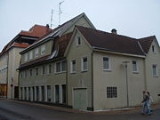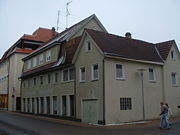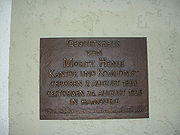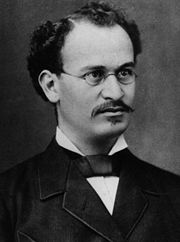
Moritz Henle
Encyclopedia




Germany
Germany , officially the Federal Republic of Germany , is a federal parliamentary republic in Europe. The country consists of 16 states while the capital and largest city is Berlin. Germany covers an area of 357,021 km2 and has a largely temperate seasonal climate...
composer
Composer
A composer is a person who creates music, either by musical notation or oral tradition, for interpretation and performance, or through direct manipulation of sonic material through electronic media...
of liturgical music and cantor
Hazzan
A hazzan or chazzan is a Jewish cantor, a musician trained in the vocal arts who helps lead the congregation in songful prayer.There are many rules relating to how a cantor should lead services, but the idea of a cantor as a paid professional does not exist in classical rabbinic sources...
of the Jewish reform movement
Reform Judaism
Reform Judaism refers to various beliefs, practices and organizations associated with the Reform Jewish movement in North America, the United Kingdom and elsewhere. In general, it maintains that Judaism and Jewish traditions should be modernized and should be compatible with participation in the...
.
Henle was born in the Upper Swabia
Upper Swabia
Upper Swabia is a region in Germany in the federal states of Baden-Württemberg and Bavaria. The name refers to the area between the Swabian Alb, Lake Constance and the Lech...
n town of Laupheim
Laupheim
Laupheim is a city in southern Germany in the state of Baden Württemberg. Laupheim was first mentioned in 778 and gained its city rights in 1869. One of the main trading routes, from Ulm to Ravensburg and then on towards Lake Constance ran through Laupheim...
at a time when Laupheim had the largest Jewish community in the Kingdom of Württemberg
History of Württemberg
Württemberg developed as a political entity in south-west Germany, with the core established around Stuttgart by Count Conrad . His descendants managed to expand Württemberg, surviving Germany's religious wars, changes in imperial policy, and invasions from France. The state had a basic...
. He was the seventh of eleven children. The family of his mother Klara Adler had been residents of Laupheim since the 18th century. In 1847 she married Elkan Henle, who had come to Laupheim from Ichenhausen
Ichenhausen
Ichenhausen is a town in the district of Günzburg, in Bavaria, Germany. It is situated on the river Günz, 9 km south of Günzburg....
. Elkan Henle was a highly respected master glazier
Glazier
A Glazier is a construction professional who selects, cuts, installs, replaces, and removes residential, commercial, and artistic glass. Glaziers also install aluminum storefront frames and entrances, glass handrails and balustrades, shower enclosures, curtain wall framing and glass and mirror...
who designed and executed the new Protestant prayer room at Großlaupheim Castle in 1847. Remaining evidence of Elkan Henle's artistic interest is the portal of the Jewish cemetery in Laupheim, which was designed by him.
From an early age, Henle showed a talent for music. He was a member of the boys choir
Choir
A choir, chorale or chorus is a musical ensemble of singers. Choral music, in turn, is the music written specifically for such an ensemble to perform.A body of singers who perform together as a group is called a choir or chorus...
at the synagogue
Synagogue
A synagogue is a Jewish house of prayer. This use of the Greek term synagogue originates in the Septuagint where it sometimes translates the Hebrew word for assembly, kahal...
in Laupheim. He was interested in learning to play the violin
Violin
The violin is a string instrument, usually with four strings tuned in perfect fifths. It is the smallest, highest-pitched member of the violin family of string instruments, which includes the viola and cello....
and the piano
Piano
The piano is a musical instrument played by means of a keyboard. It is one of the most popular instruments in the world. Widely used in classical and jazz music for solo performances, ensemble use, chamber music and accompaniment, the piano is also very popular as an aid to composing and rehearsal...
and was encouraged by his parents in these efforts. Due to initial financial help from Simon Heinrich Steiner, one of the co-founders of Hopsteiner, Moritz Henle was able to join the conservatoire at Stuttgart
Stuttgart
Stuttgart is the capital of the state of Baden-Württemberg in southern Germany. The sixth-largest city in Germany, Stuttgart has a population of 600,038 while the metropolitan area has a population of 5.3 million ....
, where he attended lessons in piano, violin and singing
Singing
Singing is the act of producing musical sounds with the voice, and augments regular speech by the use of both tonality and rhythm. One who sings is called a singer or vocalist. Singers perform music known as songs that can be sung either with or without accompaniment by musical instruments...
. However, after two years Henle had to leave the conservatoire because his parents could no longer afford its tuition. Henle then took up teaching as a more secure career. In 1864 Henle attended teacher college in Esslingen
Esslingen am Neckar
Esslingen am Neckar is a city in the Stuttgart Region of Baden-Württemberg in southern Germany, capital of the District of Esslingen as well as the largest city in the district....
, where he was trained to teach secular and religious education
Religious education
In secular usage, religious education is the teaching of a particular religion and its varied aspects —its beliefs, doctrines, rituals, customs, rites, and personal roles...
. The supreme Jewish authorities of Württemberg required Jewish teachers to train as cantors to supplement their income, as they were permitted to teach onlyl Jewish children.
After finishing teacher training in 1868, Henle began as a teacher and cantor in Laupheim, where he also gave music lessons at the Jewish elementary school, and contributed to services at the synagogue during Shabbat
Shabbat
Shabbat is the seventh day of the Jewish week and a day of rest in Judaism. Shabbat is observed from a few minutes before sunset on Friday evening until a few minutes after when one would expect to be able to see three stars in the sky on Saturday night. The exact times, therefore, differ from...
s and holidays
Jewish holiday
Jewish holidays are days observed by Jews as holy or secular commemorations of important events in Jewish history. In Hebrew, Jewish holidays and festivals, depending on their nature, may be called yom tov or chag or ta'anit...
. He was the director of the Jewish choral society Frohsinn ("Cheerfulness") and founded a mixed choir for the synagogue and took part in public concerts. After the end of the Franco-Prussian War
Franco-Prussian War
The Franco-Prussian War or Franco-German War, often referred to in France as the 1870 War was a conflict between the Second French Empire and the Kingdom of Prussia. Prussia was aided by the North German Confederation, of which it was a member, and the South German states of Baden, Württemberg and...
in 1871 the city council commissioned the 21-year-old Henle to compose a peace hymn which was performed by the city's three male choirs, reflecting the esteem in which his musical talent was already held.
In 1873 Henle went to Ulm
Ulm
Ulm is a city in the federal German state of Baden-Württemberg, situated on the River Danube. The city, whose population is estimated at 120,000 , forms an urban district of its own and is the administrative seat of the Alb-Donau district. Ulm, founded around 850, is rich in history and...
to become hazzan at the newly built synagogue there. As there was no Jewish elementary school in Ulm, Henle concentrated on religious service, directing the choir as well as religious and music education. He also resumed his studies at the Stuttgart conservatoire in composition and singing. In 1877 he earned his teaching license and a year later was approved as a cantor.
His talent had come to the attention of rabbi
Rabbi
In Judaism, a rabbi is a teacher of Torah. This title derives from the Hebrew word רבי , meaning "My Master" , which is the way a student would address a master of Torah...
Max Sänger from Hamburg
Hamburg
-History:The first historic name for the city was, according to Claudius Ptolemy's reports, Treva.But the city takes its modern name, Hamburg, from the first permanent building on the site, a castle whose construction was ordered by the Emperor Charlemagne in AD 808...
, and in 1879 he was invited to perform at the reform Hamburg Temple
Hamburg Temple
The Hamburg Temple was the synagogue of the Jewish reform movement in Hamburg from 1818 to 1938. It was the first reform synagogue in Germany....
with the prospect of getting a permanent tenure there. He was also asked to perform in Königsberg
Königsberg
Königsberg was the capital of East Prussia from the Late Middle Ages until 1945 as well as the northernmost and easternmost German city with 286,666 inhabitants . Due to the multicultural society in and around the city, there are several local names for it...
, East-Prussia, but left the position as cantor to his friend Eduard Birnbaum accepted the offer from Hamburg, where he immediately formed a mixed choir. One member of the mixed choir was Caroline Franziska Herschel, who was related to Moses Mendelssohn
Moses Mendelssohn
Moses Mendelssohn was a German Jewish philosopher to whose ideas the renaissance of European Jews, Haskalah is indebted...
. They married in 1882, and from that date on Henle's wife accompanied him at his performances and official functions. They had three children, Alwin, Paul William and Albertine.
Henle composed mostly for mixed choirs accompanied by organ, revolutionary at the time, given the traditionally strict separation of men and women in the synagogue. During Henle's thirty-four years as main cantor in Hamburg, he also worked as an author, developed the choirs of the reform synagogue, trained future singers and cantors, and was chairman of the German Association of Cantors for more than fifteen years.
Henle reintroduced biblical cantillation
Cantillation
Cantillation is the ritual chanting of readings from the Hebrew Bible in synagogue services. The chants are written and notated in accordance with the special signs or marks printed in the Masoretic text of the Hebrew Bible to complement the letters and vowel points...
and Ashkenazi
Ashkenazi Jews
Ashkenazi Jews, also known as Ashkenazic Jews or Ashkenazim , are the Jews descended from the medieval Jewish communities along the Rhine in Germany from Alsace in the south to the Rhineland in the north. Ashkenaz is the medieval Hebrew name for this region and thus for Germany...
pronunciation at the Hamburg synagogue. Until then the cantors of the Hamburg synagogue had used Sephardic
Sephardi Jews
Sephardi Jews is a general term referring to the descendants of the Jews who lived in the Iberian Peninsula before their expulsion in the Spanish Inquisition. It can also refer to those who use a Sephardic style of liturgy or would otherwise define themselves in terms of the Jewish customs and...
recitative
Recitative
Recitative , also known by its Italian name "recitativo" , is a style of delivery in which a singer is allowed to adopt the rhythms of ordinary speech...
and Portuguese
Portuguese language
Portuguese is a Romance language that arose in the medieval Kingdom of Galicia, nowadays Galicia and Northern Portugal. The southern part of the Kingdom of Galicia became independent as the County of Portugal in 1095...
pronunciation of Hebrew
Hebrew language
Hebrew is a Semitic language of the Afroasiatic language family. Culturally, is it considered by Jews and other religious groups as the language of the Jewish people, though other Jewish languages had originated among diaspora Jews, and the Hebrew language is also used by non-Jewish groups, such...
.
The tension between these traditions and the growing reformist movement within the congregation subsequently increased. Following the ideas of the reform movement, Henle introduced new concepts by employing traditions of his Southern German birthplace in his compositions, which were also influenced by the works of his wife's cousin, Felix Mendelssohn-Bartholdy
Felix Mendelssohn
Jakob Ludwig Felix Mendelssohn Barthóldy , use the form 'Mendelssohn' and not 'Mendelssohn Bartholdy'. The Grove Dictionary of Music and Musicians gives ' Felix Mendelssohn' as the entry, with 'Mendelssohn' used in the body text...
, who influenced Henle's contemporaries as well. Henle was also influenced by the works of Viennese
Vienna
Vienna is the capital and largest city of the Republic of Austria and one of the nine states of Austria. Vienna is Austria's primary city, with a population of about 1.723 million , and is by far the largest city in Austria, as well as its cultural, economic, and political centre...
cantor and composer Salomon Sulzer
Salomon Sulzer
Salomon Sulzer was an Austrian hazzan and composer. His family, which prior to 1813 bore the name of Levi, removed to Hohenems from Sulz in 1748. He was educated for the cantorate, studying first under the cantors of Endingen and Karlsruhe, with whom he traveled extensively, and later under...
.
Henle's efforts to reform the musical liturgy in Hamburg were ultimately successful, and his mixed choir became famous for its performances, which also benefited the fortunes of the synagogue.
Henle's compositions were highly regarded and used not only by reform congregations in Germany but also in the United States
United States
The United States of America is a federal constitutional republic comprising fifty states and a federal district...
. They were published in 1900 in Kompositionen von M. Henle, containing thirty hymns, and in 1913 a Haggadah
Haggadah of Pesach
The Haggadah is a Jewish text that sets forth the order of the Passover Seder. Reading the Haggadah at the Seder table is a fulfillment of the Scriptural commandment to each Jew to "tell your son" of the Jewish liberation from slavery in Egypt as described in the Book of Exodus in the Torah...
for the Passover
Passover
Passover is a Jewish holiday and festival. It commemorates the story of the Exodus, in which the ancient Israelites were freed from slavery in Egypt...
celebration at home included compositions by Henle and Jacques Offenbach
Jacques Offenbach
Jacques Offenbach was a Prussian-born French composer, cellist and impresario. He is remembered for his nearly 100 operettas of the 1850s–1870s and his uncompleted opera The Tales of Hoffmann. He was a powerful influence on later composers of the operetta genre, particularly Johann Strauss, Jr....
.
Henle died in Hamburg in 1925. His wife Caroline perished in Theresienstadt concentration camp
Theresienstadt concentration camp
Theresienstadt concentration camp was a Nazi German ghetto during World War II. It was established by the Gestapo in the fortress and garrison city of Terezín , located in what is now the Czech Republic.-History:The fortress of Terezín was constructed between the years 1780 and 1790 by the orders...
in 1943.
Moritz Henle Street in Laupheim commemorates him.
See also
- History of religious Jewish musicHistory of religious Jewish music- Origin of Jewish music in the Temple :The earliest synagogal music was based on the same system as that used in the Temple in Jerusalem. According to the Talmud, Joshua ben Hananiah, who had served in the sanctuary Levitical choir, told how the choristers went to the synagogue from the orchestra...
- History of the Jews in LaupheimHistory of the Jews in LaupheimThe History of the Jews in Laupheim began in the first half of the 18th century. Until the second half of the 19th century, the Jewish community in Laupheim expanded continuously to become the largest of its kind in Württemberg...
- LaupheimLaupheimLaupheim is a city in southern Germany in the state of Baden Württemberg. Laupheim was first mentioned in 778 and gained its city rights in 1869. One of the main trading routes, from Ulm to Ravensburg and then on towards Lake Constance ran through Laupheim...
- Reform JudaismReform JudaismReform Judaism refers to various beliefs, practices and organizations associated with the Reform Jewish movement in North America, the United Kingdom and elsewhere. In general, it maintains that Judaism and Jewish traditions should be modernized and should be compatible with participation in the...

